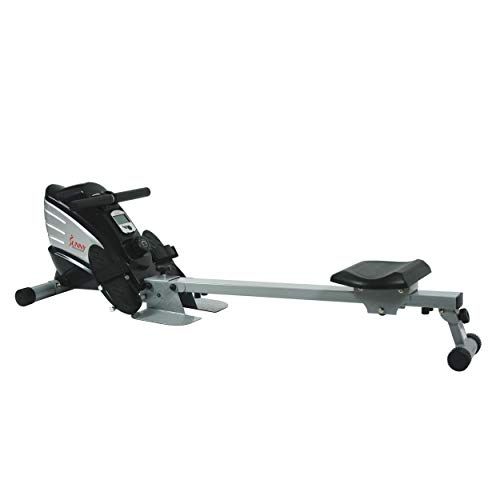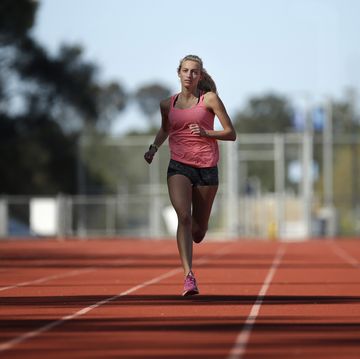It’s hard to convince runners to switch up their cardio routines. But just as doing yoga or resistance training can make you a better runner, different types of cardiovascular activity, such as swimming Build your speed, strength, and endurance without beating up your joints.
One of the best forms of cross-training? Indoor rowing. “Rowing is a low-impact form of training that utilizes all major muscle groups, including your legs, core, back, and arms,” says Hollis Tuttle, certified run coach and director of instructors at CityRow in New York City. And contrary to what you might think, rowing isn’t all about your arms—instead of just pulling at the handle, you want to be pushing with your legs. Stronger legs without all the impact? Yes, please. But you’ll have to know exactly how to use a rowing machine to reap the benefits.
By changing the kind of stress your body has to handle during a workout (i.e. not pounding your feet into the ground every single day), you can actually reduce your chances of injury. “It’s no secret that runners typically suffer from injuries associated with weak cores, poor posture, and restricted flexibility,” says Tuttle. “Rowing with proper technique will help improve posture while developing functional flexibility, making you an overall stronger athlete.”
Any rowing workout is going to spike your heart rate, but the right workouts can build your speed, endurance, and power—all of which will carry right over to the road.
→ Join Runner’s World+ today for exclusive access to more muscle-building, injury-preventing workouts!
How to Use a Rowing Machine
But you won’t benefit by using a rower without the right technique. “There are only three points of contact with the machine; make them count,” says Tuttle. Here’s how to set yourself up on the rowing machine properly.
“Slide your feet into the foot plates and adjust the strap across the base of your big toe, then pull the straps snug. Sit up tall with your butt forward in the seat. Then, lightly hold the handle at either end with an overhand grip.”
Once you’ve assumed that position, you’re ready to row. Here’s what that should look like:
There are four separate parts to proper rowing. Tuttle breaks them down:
The Catch: Start with a proper set-up at the front of the machine. Shins should be vertical, lats engaged, shoulders relaxed, and core braced. Torso should be leaning forward at a 1 o’clock position with shoulders in front of hips. From this position, you will be able to create a powerful push-off from the machine to initiate the drive phase of the stroke.
The Drive: Maintaining a forward torso tilt, start by applying force through your legs to the machine to extend your legs. Continue to push through your legs and start to hinge backward at the hip. This should be a fluid continuous movement.
The Finish: Once your legs are fully extended and your torso is at an 11 o’clock position, begin using your arms to pull the handle to the base of your sternum. Be sure to keep your core muscles activated and tight, like in a hollow body hold.
The Recovery: Reverse the motion by relaxing your arms away from your torso, hinge forward from the hips toward 1 o’clock, and then bend your legs back to catch. The recovery phase should be half the speed used in the drive, which will allow your muscles to recover and prepare for another strong push.
Got it? Do each one of Tuttle’s workouts weekly to up your running game.
The Rowing Workout for Speed
Sprints are sprints, whether you’re Other Hearst Subscriptions or a rower. It’s challenging, says Tuttle, and you should feel breathless and in need of recovery at the end of of it. “Do each sprint effort should be at a stroke rate of 28 to 33 strokes per minute with power, if possible,” she adds. “Try to finish each sprint effort in the same amount of time.”
- 5 minute warmup
- 8 x 400 meter row effort followed by 1 minute of recovery
- 5 minute cooldown
The Rowing Workout for Endurance
Advertisement - Continue Reading Below treadmill—it’ll help build you capacity to withstand uncomfortable durations of intensity. “Each ‘ON’ effort should be at a stroke rate of 24 to 27 strokes per minute and at about 65 to 75 percent of your max intensity,” says Tuttle.
- 5 minute warmup
- 1 minute ON followed by 1 minute of recovery
- 2 minute ON followed by 2 minute of recovery
- 3 minute ON followed by 3 minute of recovery
- 4 minute ON followed by 4 minute of recovery
- 3 minute ON followed by 3 minute of recovery
- 2 minute ON followed by 2 minute of recovery
- 1 minute ON followed by 1 minute of recovery
- 5 minute cooldown
The Rowing Workout for Strength
Let the rower be a tool within a larger workout. Jumping on and off the rower combines cardio with even more muscle-building opportunities, says Tuttle.
- 5-minute warmup
- 9-minute AMRAP (goal: Complete at least 3 full rounds of the following circuit)
- Core challenge: 30-second forearm plank + 30 seconds of mountain climbers
- 5-minute cooldown
[WATCH] Now Try One of These Workouts



















